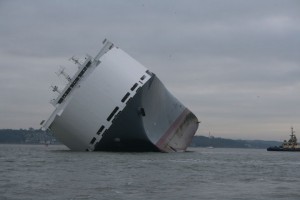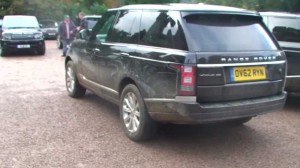The Bramble Bank in the Solent is a sandbank that is visible at low tide. Until the beginning of this year, it had been best known by people living in the area as the location for an annual cricket match between the Island Sailing Club and the Royal Southern Yacht Club.
However, on the 3rd January 2015, “The Brambles”, as it is more commonly known, drew the attention of the world’s media when a huge transporter ship by the name of the MV Hoegh Osaka ran aground on it. Unfortunately, the vessel was transporting around 1,400 Range Rovers, Jaguars, Minis and Porsche estimated to be worth in the region of £30 million to the Middle East having just left Southampton docks. There were also a number of building plant and agricultural pieces of machinery on board as well as a Rolls Royce Wraith valued at around £260,000.
Apparently, to stop the car transporter from capsizing, a decision was made to run the vessel onto the sandbank as it was starting to list significantly. In fact, it tilted by as much as 52% causing a number of the vehicles on board to be damaged bringing into question what is going to happen to the cars that were on the ship at the time. The 25 crew members were rescued by lifeboats and a helicopter with two members suffering injuries.
No doubt not helped by adverse weather conditions in the Solent, it was over two weeks before the MV Hoegh Osaka was taken back to dry land and then there was a further delay of several days before they started to remove the cars from the ship at Southampton docks A number of the cars have been scratched and dented so it remains to be seen what is going to be done about them. Some on the lower deck suffered water damage.
Many people would think that they would just repair the vehicles that have slight damage to the bodywork but no decision will be made in this respect until all the vehicles have been fully examined. The Marine Accident Investigation Branch (MAIB) is looking into what caused the 180 metre vessel to list.
Apparently, a similar incident happened in the North Pacific with a vehicle transporter called the MV Cougar Ace back in 2006. Although only 68 Mazda cars were damaged, the decision was taken to crush all 4,700 of them. One reason this decision was made was because engineers were concerned about any problems within any of the cars’ mechanical parts including the effect caused by any electrolyte that may have leaked from car batteries.
Whether a decision is made either to repair or crush the cars, it looks likely that there may be many disgruntled people who had been looking to take delivery of their new luxury cars who may have to wait a little longer than expected for them.

You must be logged in to post a comment.